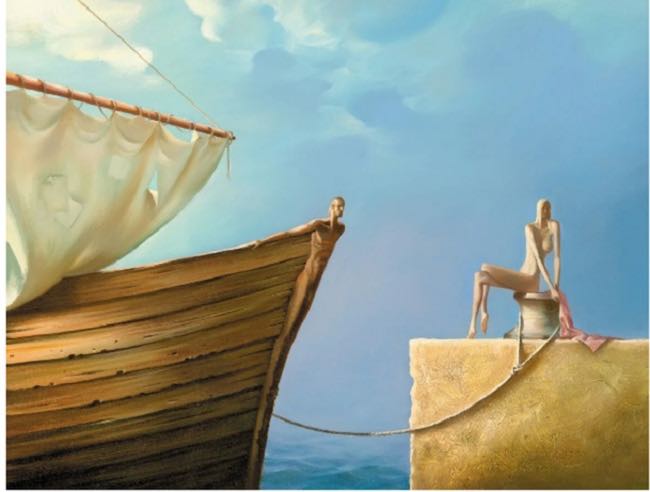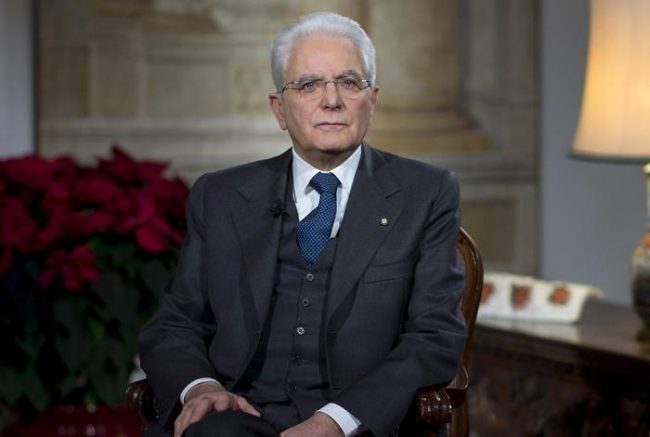La necessità degli artisti di fuggire dalla realtà contemporanea, dall’esagerato pragmatismo che contraddistingue la vita attuale al punto di diventare una vera e propria gabbia, si può manifestare in differenti modalità, esprimendosi con diversi stili, sulla base dell’approccio e del singolo modo di essere di ciascuno; alcuni tendono a immaginare un mondo fiabesco in cui tutta la realtà è modificata e diventa sogno, altri si immergono in atmosfere nebulose, a volte inquietanti, e ancora talaltri immaginano altri universi completamente staccati dalla contingenza attuale, anche per cercare e ritrovare una spiritualità ormai perduta. E poi vi sono quelli che pur necessitando tendere una mano alla magia dell’immaginazione, della poesia e della delicatezza espressiva, non rinunciano ad approfondire la loro riflessione sulle insicurezze, sui desideri inespressi e sull’esplorazione della mente dell’essere umano. L’artista di cui vi racconterò oggi non solo appartiene a quest’ultima categoria, ma la supera dando vita a un genere pittorico unico e ammaliante proprio perché muove le corde delicate con una forma esterna quasi magica, per poi condurre l’osservatore verso la ricerca del concetto più nascosto.
La necessità di evadere dalla realtà contingente si fece via via più forte agli inizi del Novecento soprattutto nel momento in cui l’intero continente europeo era avvolto dai venti di guerra che poco dopo sovvertirono tutte le certezze mettendo i popoli davanti alle atrocità e alle distruzioni del conflitto. Già con l’Espressionismo si cominciò a delineare negli artisti una forte tendenza a esprimere la propria interiorità, le insicurezze, le inquietudini avvertite dentro di sé e che non riuscivano ad associarsi alla perfezione della forma e alla ricerca estetica dei movimenti precedenti come il Realismo, l’Impressionismo, il Divisionismo; l’essere umano doveva essere protagonista assoluto anche laddove le sensazioni fossero tanto tumultuose da rompere gli schemi equilibrati della ricerca accademica o delle innovazioni impressioniste pur sempre legate alla bellezza e all’armonia, liberando così la pittura e conducendola verso l’intensità anche dove questo significasse andare verso il brutto, il deforme. Tuttavia fu il Surrealismo il movimento che riuscì a rompere ogni gabbia precedente pur rimanendo fortemente legato alla perfezione esecutiva, dal punto di vista prettamente pittorico e nell’utilizzo dei colori; nelle opere di Salvador Dalì, di René Magritte e di Yves Tanguy a emergere sono gli incubi, paesaggi post-apocalittici, dove la presenza di mostri, di presenze inquietanti, della sessualità o di riflessioni sulla futilità e inconsistenza dell’esistenza, sottolineavano e si associavano al percorso di studio compiuto dal grande maestro della psicanalisi Sigmund Freud che proprio sull’inconscio e sulle angosce dei soldati reduci di guerra fondò tutta la sua ricerca. Dopo questi grandi maestri del Novecento che tracciarono la strada per tutti quegli artisti che si sentivano, e si sentono, ingabbiati nelle pieghe della realtà, emersero altri movimenti pittorici in grado di mescolare il tratto pittorico realista con atmosfere fantastiche, immaginarie, a volte misteriose altre divertenti che si sono tradotte nella nuova interpretazione del Realismo Magico, ma anche nel Pop Surrealismo detto anche Lowbrow, che si è ampliato fino al cinema trovando in Tim Burton il proprio regista simbolo. Ma con la libertà tipica della contemporaneità un altro artista si sta affermando in maniera via via più incisiva persino elaborando un suo proprio stile pittorico denominato Realismo Metaforico perché per lui la metafora, il concetto, l’allegoria, rappresentano il mezzo per evadere dalla contingenza, per spostarsi verso un universo ideale a metà tra il sogno e la necessità di restare in qualche modo agganciati ai significati reali, quelli della vita quotidiana.
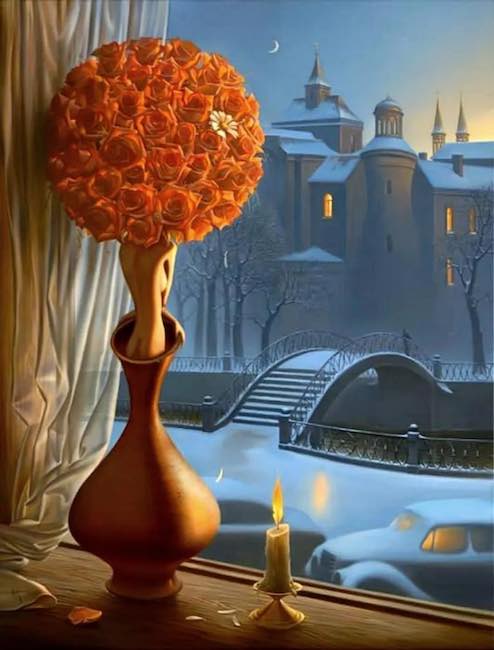
Questo innovatore risponde al nome di Vladimir Kush, di origini russe e da anni trasferitosi negli Stati Uniti per incrementare il suo percorso artistico e perfezionare la sua forte intuizione creativa che da un lato lo avvicina al Surrealismo ma dall’altro lo lega al Pop Surrealismo perché le sue atmosfere, sebbene decisamente meno gotiche, non possono fare a meno di condurre l’osservatore verso un universo fantastico, fatto di immaginazione, di leggerezza, di armonia pur inducendolo a scavare nel senso più profondo, quell’energia sottile e misteriosa che contraddistingue la contemporaneità malgrado l’essere umano, troppo distratto e perso nel suo pragmatismo, sembri esserne inconsapevole.
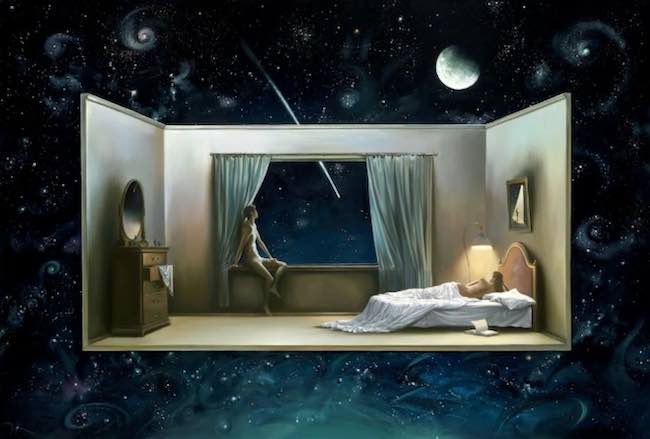
La metafora è al centro della ricerca artistica di Vladimir Kush, i simboli diventano messaggi che l’artista libera e poi lascia andare sulla tela come se fossero note musicali che giungono in maniera inconscia verso il fruitore il quale in un primo momento resta ammaliato dalla magia che traspare e poi riflette, medita e si spinge alla ricerca di quel significato nascosto che l’artista vuole trasmettere, come se le sue opere fossero uno strumento di conoscenza, di rivelazione di quella delicatezza esistenziale che potrebbe essere raggiunta se l’essere umano fosse in grado di recuperare un legame più intenso con la propria spiritualità.
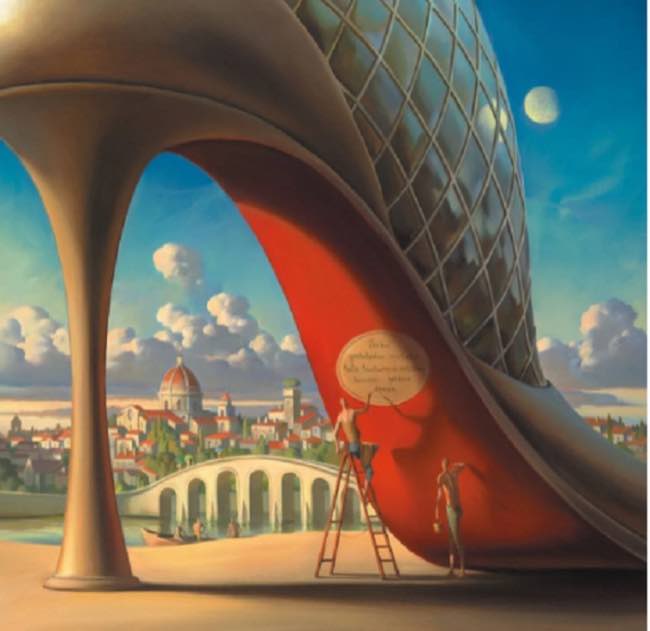
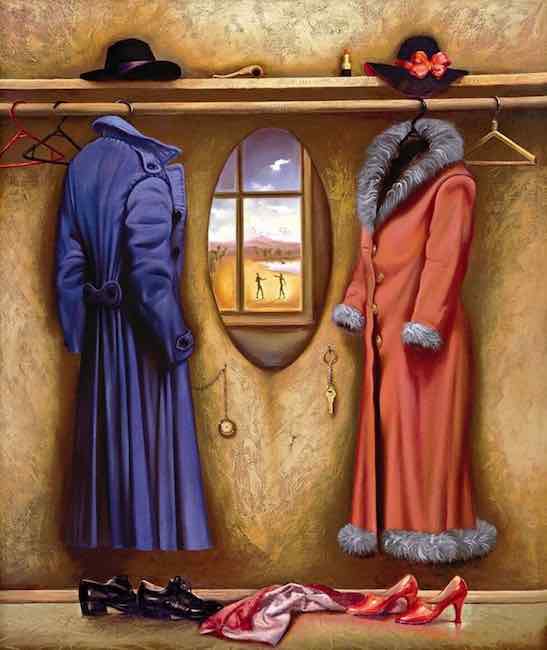
Nelle sue tele sono presenti temi imprescindibili dalla natura stessa dell’uomo, come l’amore, il sogno, il tempo, la tentazione estetica e la forte presenza malgrado l’assenza; proprio quest’ultimo è il concetto che contraddistingue l’opera Wardrobe, in qualche modo riconducibile all’evanescenza umana narrata da René Magritte pur infondendo Kush il suo personale approccio, il suo sguardo positivo e meno disilluso sulla realtà, perché qui l’uomo e la donna di cui sono presenti solo gli abiti, i cappelli e le scarpe, non sembrano rappresentare il vuoto piuttosto la loro essenza, il loro essere lì malgrado la non presenza fisica. È la sensazione di unione e di forza delle personalità dei due protagonisti a prevalere, quella di chi riesce a lasciare traccia del proprio passaggio ovunque vada e riempiendo lo spazio intorno a sé al punto di permeare gli ambienti, come avessero lasciato la loro scia.
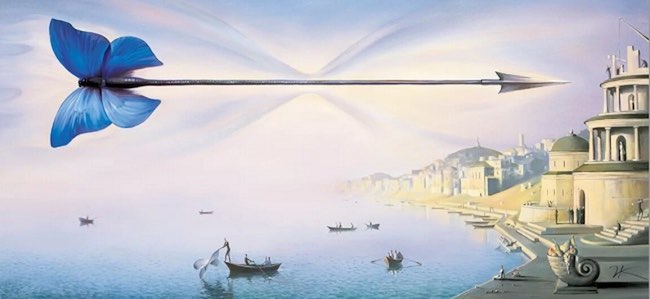
Nel dipinto Harrow of time invece l’artista affronta il tema del tempo non con la stessa ossessione di Salvador Dalì bensì considerandolo un messaggio da tramandare, osservandolo come se costituisse al contempo un insegnamento e un modo per non dimenticare le radici, le origini, le antiche civiltà che hanno gettato le basi della conoscenza e tramandato tradizioni; la freccia infatti appare nelle vesti di una farfalla, simbolo di leggerezza e di bellezza delicata, il punto di congiunzione tra il bisogno di liberarsi dal bozzolo e volare alto, e la capacità di andare avanti e indietro lassù in alto testimoniando quanto possa essere semplice riscoprire il positivo persino in ciò che a volte è stato lasciato alle spalle o di cui ci si è liberati. Il paesaggio sulla destra costituisce proprio quella radice verso cui la farfalla, rompendo la barriera del tempo, dirige la freccia per indicare all’essere umano di non trascurare quell’umanità che nel passato era considerata un valore aggiunto mentre oggi sembra costituire una debolezza.
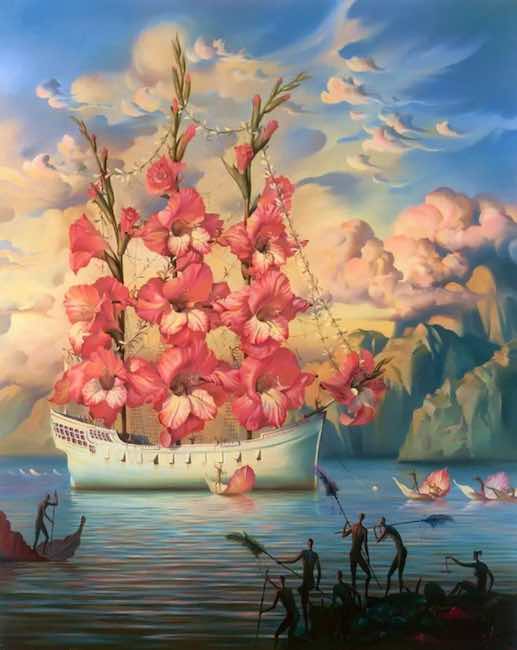
La tela Nave dei fiori svela tutto il lato romantico di Vladimir Kush che affida a un veliero il ruolo simbolico di portare armonia e serenità nel porto in cui sta per approdare, atteso da uomini piccoli, quasi come fossero il simbolo di tutte quelle motivazioni, o forse sarebbe meglio dire pretesti, che l’umanità si dà per non essere felice; infatti la parte bassa della tela, quella dove sono posizionate le persone, è al buio, come se attendesse di essere rischiarata e illuminata dai colori dei fiori, rappresentanti il sogno, la leggerezza e l’armonia enfatizzati dal rosa, tonalità per eccellenza della positività, della delicatezza. I grandi petali si trasformano in imbarcazioni attraverso cui le persone possono avvicinarsi e salire su quella nave ideale che somiglia alla speranza, alla possibilità di intraprendere un percorso migliore e più piacevole perché legato solo e unicamente ai sentimenti positivi.
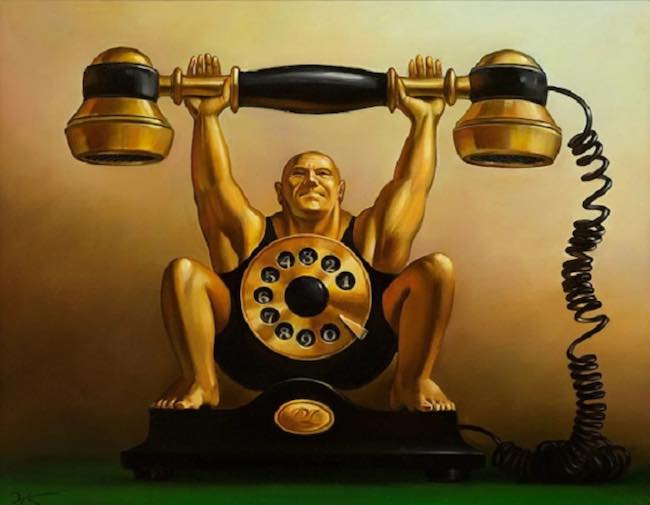
Il Surrealismo si mescola dunque alla Metafisica che assume un aspetto realista proprio perché, sembra suggerire Vladimir Kush, nella realtà della vita il confine tra ciò che è e ciò che si pensa che sia è labile, sottile, ogni porta può condurre a una verità differente e dunque lui preferisce galleggiare tra il sogno di un mondo ideale, e la certezza che possa diventare possibile proprio cullando quel sogno. Vladimir Kush ha cominciato a vendere i suoi dipinti in Germania nel 1990 poi si è spostato negli Stati Uniti dove venti sue opere sono stati esposti a Los Angeles; nel 1995 ha esposto alla Mandarin Fine Art Gallery di Hong Kong, per poi aprire la propria galleria – la Kush Fine Art – due anni dopo alle Hawaii. Le sue opere sono collezionate in tutto il mondo.
VLADIMIR KUSH-CONTATTI
Email: frank.abreu@kushfineart.com
Sito web: https://kushfineart.com/
Facebook: https://www.facebook.com/VladimirKushFineArt
Instagram: https://www.instagram.com/kushfineart/
The Metaphorical Realism of Vladimir Kush, when fantasy turns into escapism towards romantic concepts and pindaric flights
The need of artists to escape from contemporary reality, from the exaggerated pragmatism that characterises current life to the point of becoming a veritable cage, can manifest itself in different ways, expressing n different styles, based on the approach and individual way of being of each; some tend to imagine a fairy-tale world in which all reality is modified and becomes a dream, others immerse themselves in nebulous, sometimes disturbing atmospheres, and still others imagine other universes completely detached from the current contingency, also in order to seek and rediscover a spirituality now lost. And then there are those who, while needing to lend a hand to the magic of imagination, poetry and expressive delicacy, do not give up their reflections on insecurities, unexpressed desires and the exploration of the human mind. The artist I am going to tell you about today not only belongs to the latter category, but goes beyond it by creating a unique and bewitching pictorial genre precisely because he pulls on delicate strings with an almost magical external form, and then leads the observer towards the search for the most hidden concept.
The need to escape from contingent reality grew stronger and stronger at the beginning of the 20th century, especially at a time when the entire European continent was enveloped by the winds of war that shortly afterwards subverted all certainties by confronting peoples with the atrocities and destruction of the conflict. Already with Expressionism, a strong tendency began to emerge in artists to express their inner selves, their insecurities, the anxieties felt within and which could not be associated with the perfection of form and aesthetic research of previous movements such as Realism, Impressionism and Divisionism; the human being was to be the absolute protagonist even where the sensations were so tumultuous that they broke the balanced schemes of academic research or Impressionist innovations that were still linked to beauty and harmony, thus freeing painting and leading it towards intensity even where this meant going towards the ugly, the deformed. However, it was Surrealism the movement that succeeded in breaking all previous cages while remaining strongly tied to perfection in execution, from a purely pictorial point of view and in the use of colours; in the works of Salvador Dali, René Magritte and Yves Tanguy, emerge nightmares, post-apocalyptic landscapes, where the presence of monsters, disturbing presences, sexuality or reflections on the futility and inconsistency of existence underline and are associated with the path of study undertaken by the great master of psychoanalysis Sigmund Freud, who based all his research on the unconscious and the anxieties of war veterans.
After these great masters of the 20th century, who traced the path for all those artists who felt, and still feel, trapped in the folds of reality, other pictorial movements emerged that were able to mix the realist pictorial traits with fantastic, imaginary, sometimes mysterious, sometimes amusing atmospheres that resulted in the new interpretation of Magic Realism, but also in Pop Surrealism, also known as Lowbrow, which expanded as far as cinema, finding its symbolic director in Tim Burton. But with the freedom typical of the contemporary world, another artist is gradually asserting himself in a more incisive manner, even elaborating his own style of painting called Metaphorical Realism, because for him, metaphor, concept, allegory, represent the means to escape from contingency, to move towards an ideal universe somewhere between a dream and the need to remain in some way attached to real meanings, those of everyday life. This innovator answers to the name of Vladimir Kush, of Russian origin and for years relocated to the United States to further his artistic career and perfect his strong creative intuition, which on the one hand brings him closer to Surrealism but on the other binds him to Pop Surrealism because its atmospheres, although decidedly less gothic, cannot help but lead the observer towards a fantastic universe, made up of imagination, lightness and harmony while inducing him to delve into the deepest sense, that subtle and mysterious energy that characterises contemporaneity despite the fact that human beings, too distracted and lost in their pragmatism, seem to be unaware of it.
Metaphor is at the heart of Vladimir Kush’s artistic research, symbols become messages that the artist releases and then lets go on the canvas as if they were musical notes that unconsciously reach the viewer who at first is captivated by the magic that transpires and then reflects, ponders and goes in search of that hidden meaning that the artist wants to convey, as if his works were an instrument of knowledge, of revelation of that existential delicacy that could be achieved if human beings were able to recover a more intense connection with their own spirituality. In his canvases there are themes that are inseparable from the very nature of man, such as love, dreams, time, aesthetic temptation and strong presence despite absence; the latter is precisely the concept that distinguishes the work Wardrobe, in some ways referable to the human evanescence narrated by René Magritte while Kush infusing it with his personal approach, his positive and less disillusioned view of reality, because here the man and woman whose clothes, hats and shoes are only present do not seem to represent emptiness rather their essence, their being there despite their physical non-presence. It is the feeling of the unity and strength of the personalities of the two protagonists that prevails, that of those who manage to leave a trace of their passage wherever they go and fill the space around them to the point of permeating the surroundings, as if they had left their wake. In the painting Harrow of time, on the other hand, the artist does not address the theme of time with the same obsession as Salvador Dali, but considers it as a message to be passed on, observing it as if it were both a lesson and a way of not forgetting the roots, the origins, the ancient civilisations that laid the foundations of knowledge and handed down traditions; in fact, the arrow appears in the guise of a butterfly, a symbol of lightness and delicate beauty, the point of connection between the need to free oneself from the cocoon and fly high, and the ability to go back and forth from up there, testifying to how simple it can be to rediscover the positive even in what has sometimes been left behind or what one has gotten rid of.
The landscape on the right constitutes precisely that root towards which the butterfly, breaking the barrier of time, directs its arrow to indicate to human beings not to neglect that humanity which in the past was considered an added value whereas today it seems to constitute a weakness. The painting Ship of Flowers reveals all the romantic side of Vladimir Kush, who entrusts a sailing ship with the symbolic role of bringing harmony and serenity to the port where it is about to land, awaited by little men, almost as if they were the symbol of all those motivations, or perhaps it would be better to say pretexts, that humanity gives itself for not being happy; in fact, the lower part of the canvas, the one where the people are positioned, is in darkness, as if waiting to be illuminated and brightened by the colours of the flowers, representing dreams, lightness and harmony emphasised by pink, the shade par excellence of positivity, of delicacy. The large petals are transformed into vessels through which people can approach and board that ideal ship that resembles hope, the possibility of embarking on a better and more pleasant path because it is linked solely and exclusively to positive feelings. Surrealism is thus mixed with Metaphysics, which takes on a realist aspect precisely because, Vladimir Kush seems to suggest, in the reality of life the boundary between what is and what one thinks it is is shaky, subtle, every door can lead to a different truth, and so he prefers to float between the dream of an ideal world, and the certainty that it can become possible precisely by cradling that dream. Vladimir Kush started selling his paintings in Germany in 1990 and then moved to the United States where twenty of his works were exhibited in Los Angeles; in 1995 he exhibited at the Mandarin Fine Art Gallery in Hong Kong, and then opened his own gallery – Kush Fine Art – two years later in Hawaii. His artworks are collected all over the world.


